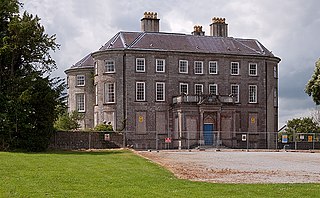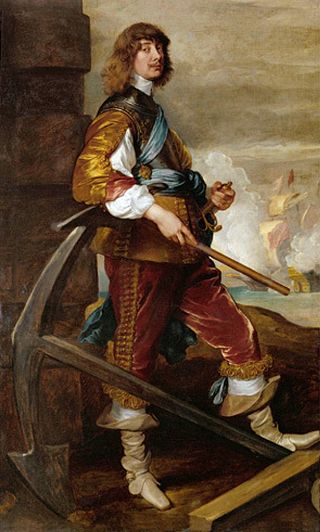Related Research Articles

The Long Parliament was an English Parliament which lasted from 1640 until 1660. It followed the fiasco of the Short Parliament, which had convened for only three weeks during the spring of 1640 after an 11-year parliamentary absence. In September 1640, King Charles I issued writs summoning a parliament to convene on 3 November 1640. He intended it to pass financial bills, a step made necessary by the costs of the Bishops' Wars against Scotland. The Long Parliament received its name from the fact that, by Act of Parliament, it stipulated it could be dissolved only with agreement of the members; and those members did not agree to its dissolution until 16 March 1660, after the English Civil War and near the close of the Interregnum.

1641 (MDCXLI) was a common year starting on Tuesday of the Gregorian calendar and a common year starting on Friday of the Julian calendar, the 1641st year of the Common Era (CE) and Anno Domini (AD) designations, the 641st year of the 2nd millennium, the 41st year of the 17th century, and the 2nd year of the 1640s decade. As of the start of 1641, the Gregorian calendar was 10 days ahead of the Julian calendar, which remained in localized use until 1923.

Denzil Holles, 1st Baron Holles, was an English statesman, best remembered as one of the Five Members whose attempted arrest by Charles I in January 1642 sparked the First English Civil War.

Sir Arthur Haselrig, 2nd Baronet was a leader of the Parliamentary opposition to Charles I and one of the Five Members whose attempted arrest sparked the 1642–1646 First English Civil War. He held various military and political posts during the 1639–1651 Wars of the Three Kingdoms but became an opponent of Oliver Cromwell during the Protectorate. In 1660, his actions inadvertently helped restore Charles II to the throne; unlike many senior Parliamentary leaders, his life was spared but he was confined to the Tower of London, where he died on 7 January 1661.

Thomas Wentworth, 1st Earl of Strafford,, was an English statesman and a major figure in the period leading up to the English Civil War. He served in Parliament and was a supporter of King Charles I. From 1632 to 1640 he was Lord Deputy of Ireland, where he established a strong authoritarian rule. Recalled to England, he became a leading advisor to the King, attempting to strengthen the royal position against Parliament. When Parliament condemned Lord Strafford to death, Charles reluctantly signed the death warrant and Strafford was executed. He had been advanced several times in the Peerage of England during his career, being created 1st Baron Wentworth in 1628, 1st Viscount Wentworth in late 1628 or early 1629, and, finally, 1st Earl of Strafford in January 1640. He was known as Sir Thomas Wentworth, 2nd Baronet, between 1614 and 1628.
Adam Loftus, 1st Viscount Loftus, was Lord Chancellor of Ireland from 1619 and from 1622 raised to the peerage of Ireland as Viscount Loftus of Ely, King's County. His uncle, another Adam Loftus, was both Lord Chancellor of Ireland and Church of Ireland primate.

Sir William St LegerPC (Ire) (1586–1642) was an Anglo-Irish landowner, administrator and soldier, who began his military career in the Eighty Years' War against Habsburg Spain. He settled in Ireland in 1624, where he was MP for County Cork in two Irish parliaments and Lord President of Munster. During the Irish Rebellion of 1641, he played a leading part in suppressing the rising in Munster before dying in 1642.

Algernon Percy, 10th Earl of Northumberland, 4th Baron Percy,, was an English aristocrat, and supporter of the Parliamentary cause in the First English Civil War.

Earl of Strafford is a title that has been created three times in English and British history.

William Wentworth, 2nd Earl of Strafford, KG, of Wentworth Woodhouse in Yorkshire, was a prominent landowner.

John Bramhall, DD was an Archbishop of Armagh, and an Anglican theologian and apologist. He was a noted controversialist who doggedly defended the English Church from both Puritan and Roman Catholic accusations, as well as the materialism of Thomas Hobbes.

The Protestation of 1641 was an attempt to avert the English Civil War. Parliament passed a bill on 3 May 1641 requiring those over the age of 18 to sign the Protestation, an oath of allegiance to King Charles I and the Church of England, as a way to reduce the tensions across the realm. Signing them was a necessity in order to hold public office. Those that were not willing to sign it were also listed under it as refusing to pledge its oath.

Thomas Dillon, 4th Viscount DillonPC (Ire) (1615–1673) held his title for 42 years that saw Strafford's administration, the Irish Rebellion of 1641, the Irish Confederate Wars and the Cromwellian Conquest of Ireland. He was a royalist and supported Strafford and Ormond. He sided with the Confederates for a while but was a moderate who opposed Rinuccini, the papal nuncio.
Sir James Dillon, 3rd Earl of Roscommon was an Irish magnate and politician. He was born a Catholic but converted at a young age to the Church of Ireland. He supported Strafford during his term as governor of Ireland. In the Confederate Wars and the Cromwellian conquest he was a royalist. He died in 1649, but was nevertheless included as the fifth on the list of people that were excluded from pardon in Cromwell's 1652 Act of Settlement.
Sir Richard Bolton was an English lawyer and judge, who was an important figure in Irish political life in the 1630s and 1640s.

Under Charles I, the Puritans became a political force as well as a religious tendency in the country. Opponents of the royal prerogative became allies of Puritan reformers, who saw the Church of England moving in a direction opposite to what they wanted, and objected to increased Catholic influence both at Court and within the Church.

William Laud was a bishop in the Church of England. Appointed Archbishop of Canterbury by Charles I in 1633, Laud was a key advocate of Charles I's religious reforms; he was arrested by Parliament in 1640 and executed towards the end of the First English Civil War in January 1645.

Sir Charles MacCarthy, 1st Viscount of Muskerry, also called Cormac Oge, especially in Irish, was from a family of Irish chieftains who were the Lords of Muskerry, related to the Old English through maternal lines. He became the 17th Lord of Muskerry upon his father's death in 1616. He acquired a noble title under English law, becoming 1st Viscount Muskerry and 1st Baron Blarney under letters patent. He sat in the House of Lords in both Irish parliaments of King Charles I. He opposed Strafford, the king's viceroy in Ireland, and in 1641 contributed to his demise by submitting grievances to the king in London. Muskerry died during this mission and was buried in Westminster Abbey.
The Parliament 1640–1649, also called Parliament 1639–1648 using an unadjusted Old Style (O.S.) calendar, was the second of the two Irish parliaments of King Charles I of England. It voted taxes in 1640 and was then overshadowed by the Irish Rebellion of 1641. It was legally dissolved by the King's death in 1649.

Nicholas Preston, 6th Viscount Gormanston (1606–1643) sat in the House of Lords of the Irish Parliament of 1634–1635 and sided with the insurgents after the Irish Rebellion of 1641.
References
- 1 2 3 4 5 6 7 8 9 10 "British Civil Wars, Commonwealth and Protectorate 1638-60". Archived from the original on 2017-09-06. Retrieved 2007-06-02.
- ↑ Fritze, Ronald (1996). Historical dictionary of Stuart England, 1603-1689. Westport, CT: Greenwood Press. p. 311. ISBN 9780313283918.
- ↑ Smith, David L. (1999). The Stuart Parliaments 1603–1689. Arnold Press. p. 123.
- ↑ Wooding, Barbara (2013). John Lowin and the English Theatre, 1603–1647: Acting and Cultural Politics on the Jacobean and Caroline Stage. Ashgate Publishing. p. 209. ISBN 978-1-4724-0687-3.
- ↑ "The Ship of Gold: The '£1 Billion' Lost Treasure of the Merchant Royal". Sky Network/History Channel.
- ↑ According to a later account of a journalist who witnesses the events, John Rushworth.
- ↑ "Anthony van Dyck". Netherlands Institute of Art. Retrieved 2021-03-20.